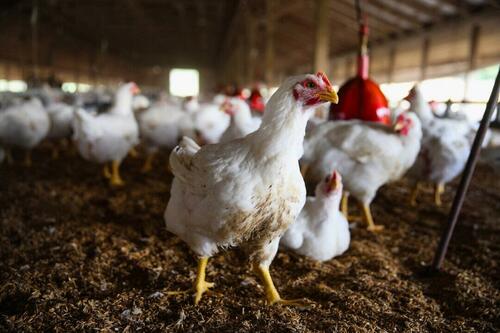
Authored by Zachary Stieber via The Epoch Times (emphasis ours),

A new human case of highly pathogenic avian influenza has been confirmed, officials at the U.S. Centers for Disease Control and Prevention (CDC) said on May 30.
The patient is a Michigan resident who works with dairy cows. The patient’s age, gender, and work location weren’t disclosed by federal or state officials.
The patient likely contracted the bird flu from cattle, officials said. The person experienced symptoms after “direct exposure to an infected cow,” Dr. Natasha Bagdasarian, Michigan’s chief medical executive, said in a statement.
The case is the third confirmed among humans in the United States this year. The previously confirmed cases, one each in Texas and Michigan, also cropped up in farm workers.
Both of those workers experienced inflamed eyes and have since recovered, as did a person who contracted the illness in Colorado in 2022.
Globally, more than half of cases reported to the World Health Organization since the early 2000s have resulted in death.
The new case is from a different farm than the earlier case in the state, according to Michigan authorities.
The new patient experienced symptoms including cough without fever and eye discomfort with watery discharge. The person was given an antiviral, is isolating at home, and is seeing the resolution of their symptoms, according to the CDC.
Antivirals used against influenza include oseltamivir, also known as Tamiflu.
The person wasn’t wearing personal protective equipment (PPE).
“This tells us that direct exposure to infected livestock poses a risk to humans, and that PPE is an important tool in preventing spread among individuals who work on dairy and poultry farms,” Dr. Bagdasarian said.
None of the patient’s contacts have developed symptoms, and none of the farm’s other workers have reported symptoms.
There’s no signs of person-to-person transmission of the influenza, also known as the bird flu or H5N1, CDC and Michigan officials said.
While the CDC maintains that the risk to the general public is low, it says farm workers are at greater risk and advises them to take a number of precautions, including wearing masks and gloves when dealing with animals with suspected or confirmed cases.
There are about 105,800 workers on U.S. dairy farms as of 2023, according to IBISWorld.
The bird flu jumped to cows in late 2023 or earlier this year, according to U.S. Department of Agriculture scientists.
Cases have since been confirmed in 67 herds across nine states, including Michigan, the department says.
The flu has also spread to other species in recent years, including foxes, bears, and alpacas.
US Floats Bulk Milk Testing
The Department of Agriculture (USDA) recently proposed allowing farmers to bulk test the milk of their dairy cows for bird flu rather than test milk from individual cows before gaining approval to ship them across state lines, according to state and industry officials and agency documents.
The department in late April began requiring lactating cows to test negative before being shipped across state lines. It later said the order likely helped prevent the spread of the virus to new states.
The USDA reported 2,492 pre-movement tests as of Wednesday but said that number does not equal the number of animals tested.
A pilot program for bulk testing milk could begin in June for farmers who choose to participate, according to documents the USDA sent to industry officials this week.
Agriculture officials in six states said on May 29 they were reviewing the USDA’s proposal for the program. The USDA declined to comment.
“Once it has support and participation from farms, the USDA program could help reduce the threat of H5N1 in dairy herds, further mitigate risk among farm workers, and continue to protect our nation’s commercial milk supply,” the International Dairy Foods Association said in a statement.
The U.S. Food and Drug Administration estimated that 20 percent of the U.S. milk supply shows signs of the virus, although further testing found no viable virus.
Farmers said testing milk from bulk storage tanks offers the chance to collect a sample from all the cows within a herd and would be more efficient than testing samples from individual animals.
Bulk tanks of milk from individual herds would need three consecutive weeks of negative testing results to show the herd is free of bird flu and enter the new program, according to USDA documents dated May 24.
Farmers would then need to submit milk samples from bulk tanks weekly to maintain their status, the documents say. Continued negative results would mean no additional testing is needed before shipping cattle between states, according to the documents.
Three weeks of testing milk from bulk tanks isn’t enough to confirm a herd is free of bird flu, though, said Gail Hansen, a veterinary and public health consultant. Samples from healthy cows could dilute samples from a small number of infected cattle in the same herd when their milk mixes in the tank, she said.
“It may give people a false sense of assurance,” Ms. Hansen said.
Reuters contributed to this report.
Authored by Zachary Stieber via The Epoch Times (emphasis ours),

A new human case of highly pathogenic avian influenza has been confirmed, officials at the U.S. Centers for Disease Control and Prevention (CDC) said on May 30.
The patient is a Michigan resident who works with dairy cows. The patient’s age, gender, and work location weren’t disclosed by federal or state officials.
The patient likely contracted the bird flu from cattle, officials said. The person experienced symptoms after “direct exposure to an infected cow,” Dr. Natasha Bagdasarian, Michigan’s chief medical executive, said in a statement.
The case is the third confirmed among humans in the United States this year. The previously confirmed cases, one each in Texas and Michigan, also cropped up in farm workers.
Both of those workers experienced inflamed eyes and have since recovered, as did a person who contracted the illness in Colorado in 2022.
Globally, more than half of cases reported to the World Health Organization since the early 2000s have resulted in death.
The new case is from a different farm than the earlier case in the state, according to Michigan authorities.
The new patient experienced symptoms including cough without fever and eye discomfort with watery discharge. The person was given an antiviral, is isolating at home, and is seeing the resolution of their symptoms, according to the CDC.
Antivirals used against influenza include oseltamivir, also known as Tamiflu.
The person wasn’t wearing personal protective equipment (PPE).
“This tells us that direct exposure to infected livestock poses a risk to humans, and that PPE is an important tool in preventing spread among individuals who work on dairy and poultry farms,” Dr. Bagdasarian said.
None of the patient’s contacts have developed symptoms, and none of the farm’s other workers have reported symptoms.
There’s no signs of person-to-person transmission of the influenza, also known as the bird flu or H5N1, CDC and Michigan officials said.
While the CDC maintains that the risk to the general public is low, it says farm workers are at greater risk and advises them to take a number of precautions, including wearing masks and gloves when dealing with animals with suspected or confirmed cases.
There are about 105,800 workers on U.S. dairy farms as of 2023, according to IBISWorld.
The bird flu jumped to cows in late 2023 or earlier this year, according to U.S. Department of Agriculture scientists.
Cases have since been confirmed in 67 herds across nine states, including Michigan, the department says.
The flu has also spread to other species in recent years, including foxes, bears, and alpacas.
US Floats Bulk Milk Testing
The Department of Agriculture (USDA) recently proposed allowing farmers to bulk test the milk of their dairy cows for bird flu rather than test milk from individual cows before gaining approval to ship them across state lines, according to state and industry officials and agency documents.
The department in late April began requiring lactating cows to test negative before being shipped across state lines. It later said the order likely helped prevent the spread of the virus to new states.
The USDA reported 2,492 pre-movement tests as of Wednesday but said that number does not equal the number of animals tested.
A pilot program for bulk testing milk could begin in June for farmers who choose to participate, according to documents the USDA sent to industry officials this week.
Agriculture officials in six states said on May 29 they were reviewing the USDA’s proposal for the program. The USDA declined to comment.
“Once it has support and participation from farms, the USDA program could help reduce the threat of H5N1 in dairy herds, further mitigate risk among farm workers, and continue to protect our nation’s commercial milk supply,” the International Dairy Foods Association said in a statement.
The U.S. Food and Drug Administration estimated that 20 percent of the U.S. milk supply shows signs of the virus, although further testing found no viable virus.
Farmers said testing milk from bulk storage tanks offers the chance to collect a sample from all the cows within a herd and would be more efficient than testing samples from individual animals.
Bulk tanks of milk from individual herds would need three consecutive weeks of negative testing results to show the herd is free of bird flu and enter the new program, according to USDA documents dated May 24.
Farmers would then need to submit milk samples from bulk tanks weekly to maintain their status, the documents say. Continued negative results would mean no additional testing is needed before shipping cattle between states, according to the documents.
Three weeks of testing milk from bulk tanks isn’t enough to confirm a herd is free of bird flu, though, said Gail Hansen, a veterinary and public health consultant. Samples from healthy cows could dilute samples from a small number of infected cattle in the same herd when their milk mixes in the tank, she said.
“It may give people a false sense of assurance,” Ms. Hansen said.
Reuters contributed to this report.
Loading…





